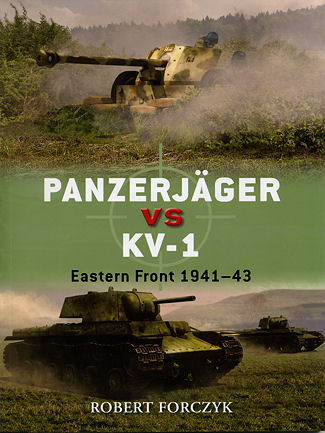 A lot of
people took Soviet technology for granted during the late 1930s and early 1940s.
One area was in heavy tanks. When the Germans invaded the Soviet Union in mid
1941, it came as a rude shock that they had a considerable number of heavy tanks
in their arsenal. These tanks were totally impervious to any of the German
anti-tank weapons and only by using 10 inch howitzers with armor piercing rounds
and the 88mm flak guns were the armor on these tanks able to be penetrated.
A lot of
people took Soviet technology for granted during the late 1930s and early 1940s.
One area was in heavy tanks. When the Germans invaded the Soviet Union in mid
1941, it came as a rude shock that they had a considerable number of heavy tanks
in their arsenal. These tanks were totally impervious to any of the German
anti-tank weapons and only by using 10 inch howitzers with armor piercing rounds
and the 88mm flak guns were the armor on these tanks able to be penetrated.
Ironically, the armament folks had developed a 75mm anti-tank
gun, but it was not put into production as it was felt it was not needed. After
all, all the Soviets had were light tanks and a few lumbering T-35s that often
broke down before even seeing combat. It was felt that the 3.7cm and 5.0cm
anti-tank guns would be enough. They were pretty much just a nuisance to the KV
crews. It wasn't until early-mid 1942 that proper anti-tank weapons were
available to defeat the KV tanks. Then it was all down hill for the KV until it
was finally withdrawn from front line service during 1943.
So, what kept the Soviet heavy tanks from pushing back the
Germans early in the invasion? It was a major lack of training and qualified
leadership. Thanks to Stalin's paranoid purges of most of his officer corps as
well as many qualified NCOs, the Soviet army had to pretty much start from
scratch. Tank crews did not know how to drive the tanks and frequently burned
out the clutches just getting them to the front lines (fast these were not as
they were designed as infantry support tanks). Tank leaders often could not even
read maps and drove their units into marshes where the tanks became bogged down
and so stuck they could not be pulled out. To make matters worse, supply was
non-existent and often tanks ran out of fuel before reaching the fighting. Add
to this that often there was only enough ammo in the tank to use with no
additional rounds available and some tanks went into battle with no ammunition,
the idea to get it out of other tanks that were out of service.
No wonder the Soviets were in mass retreat during the opening
stages of the invasion.
In this latest edition of the Duel series, author Robert
Forczyk takes a close look at the usual machinations of the Soviet
military-industrial complex and what it took to get the KV tanks into
production. He then goes through the development of the KV tank on the Soviet
side and anti-tank units on the German side. We then look at the political
situation on both sides as well as the technical specs on the two weapon types.
This is followed by the organization and training of the combatants before many
pages of combat tales and information. This ends with an analysis of what
was learned and how this affected future events.
This is accompanied by some excellent period photos and
modern illustrations and maps to let the reader get an idea of how the situation
changed with time. It makes for a superb read and one I can most highly recommend.
November 2012
For more on the complete line of Osprey books,
visit www.ospreypublishing.com. In the US, it is
Osprey Direct at 443 Park Avenue South, New York, NY 10016, where you can
get a catalogue of available books.
If you would like your product reviewed fairly and quickly, please contact
me or see other details in the Note to
Contributors.
 A lot of
people took Soviet technology for granted during the late 1930s and early 1940s.
One area was in heavy tanks. When the Germans invaded the Soviet Union in mid
1941, it came as a rude shock that they had a considerable number of heavy tanks
in their arsenal. These tanks were totally impervious to any of the German
anti-tank weapons and only by using 10 inch howitzers with armor piercing rounds
and the 88mm flak guns were the armor on these tanks able to be penetrated.
A lot of
people took Soviet technology for granted during the late 1930s and early 1940s.
One area was in heavy tanks. When the Germans invaded the Soviet Union in mid
1941, it came as a rude shock that they had a considerable number of heavy tanks
in their arsenal. These tanks were totally impervious to any of the German
anti-tank weapons and only by using 10 inch howitzers with armor piercing rounds
and the 88mm flak guns were the armor on these tanks able to be penetrated.